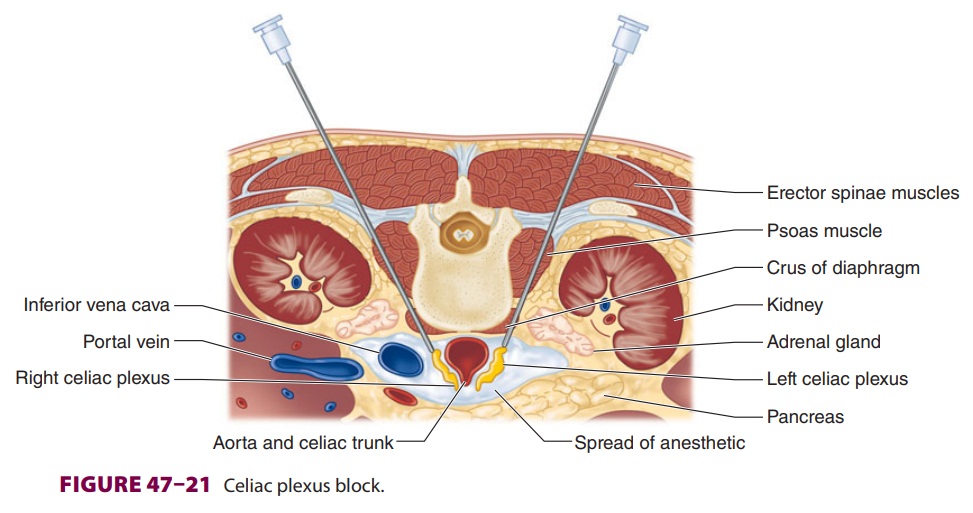Chapter: Clinical Anesthesiology: Regional Anesthesia & Pain Management: Chronic Pain Management
Celiac Plexus Block

Celiac Plexus Block
A. Indications
A celiac plexus block is indicated for patients with pain arising from
the abdominal viscera, particu-larly intraabdominal cancers.
B. Anatomy
The celiac ganglia vary in number (1–5), form, and position. They are generally clustered at the level of the body of L1, posterior to the vena cava on the right, just lateral to the aorta on the left, and poste-rior to the pancreas.
C. Technique
The patient is placed in a prone position and
a 15-cm 22-gauge needle is used to inject 15–20 mL of local anesthetic (Figure
47–21). Under fluoroscopic guid-ance, each needle
is inserted 7–8 cm from the mid-line at the inferior edge of the spinous
process of L1. It is advanced under radiographic guidance toward the midline,
making an approximately 10–45° angle. The needle passes under the edge of the twelfth rib and should
be positioned anterior to the body of L1 in the lateral radiographic view and
close to the mid-line overlying the same vertebral body in the antero-posterior
view. When CT guidance is used, the tip of the needle should come to lie
anterolateral to the aorta at a level between the celiac and superior
mes-enteric arteries.

The celiac plexus block may be performed from
multiple approaches including a posterior retrocru-ral approach, a posterior
anterocrural approach, a posterior transaortic approach, and an anterior
approach. These blocks may be facilitated with the use of fluoroscopy, CT, or
ultrasound guidance.
D. Complications
The most common complication is postural hypo-tension, from block of the visceral sympathetic innervation and resultant vasodilation. For this rea-son, patients should be adequately hydrated intrave-nously prior to this block. Accidental intravascular injection into the vena cava is more likely to produce a severe systemic reaction than accidental intraaor-tic injection. Other, less common, complications include pneumothorax, retroperitoneal hemor-rhage, injury to the kidneys or pancreas, sexual dys-function, or, rarely, paraplegia (due to injury to the lumbar artery of Adamkiewicz). Blocking the sym-pathetic chain may result in relatively unopposed parasympathetic activity that may lead to increased gastrointestinal motility and diarrhea. Back pain is another common side effect of a celiac plexus block.
Related Topics